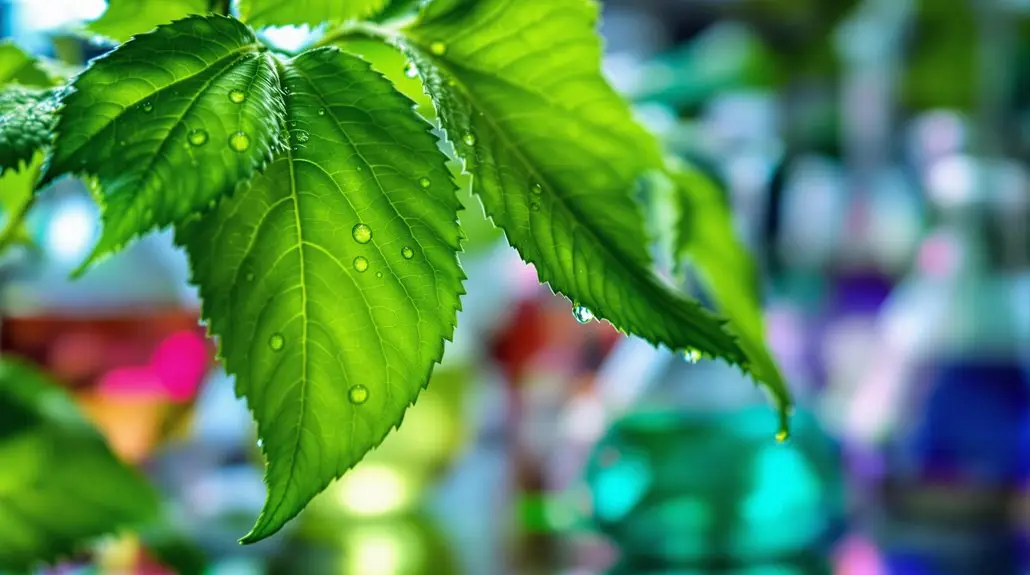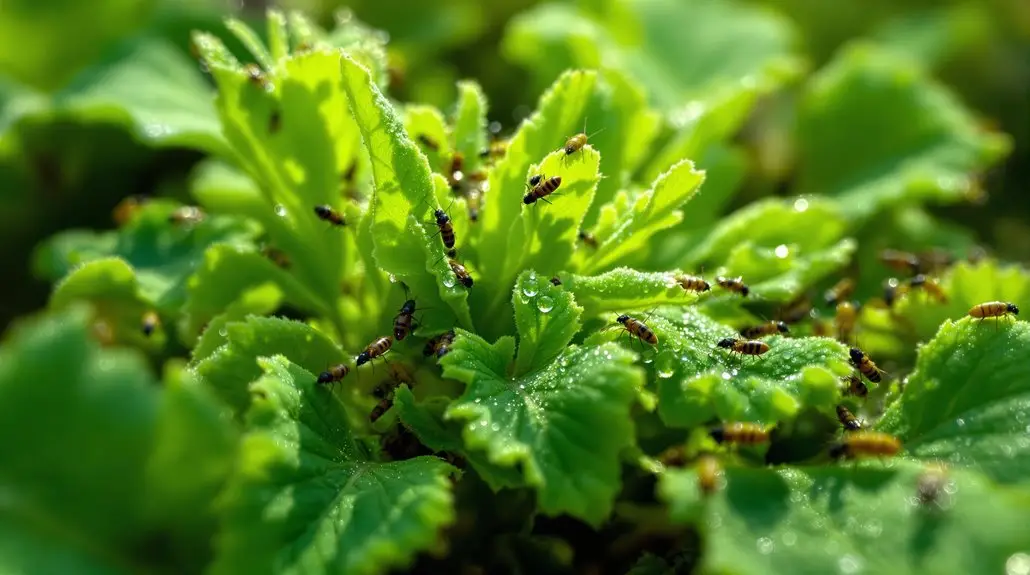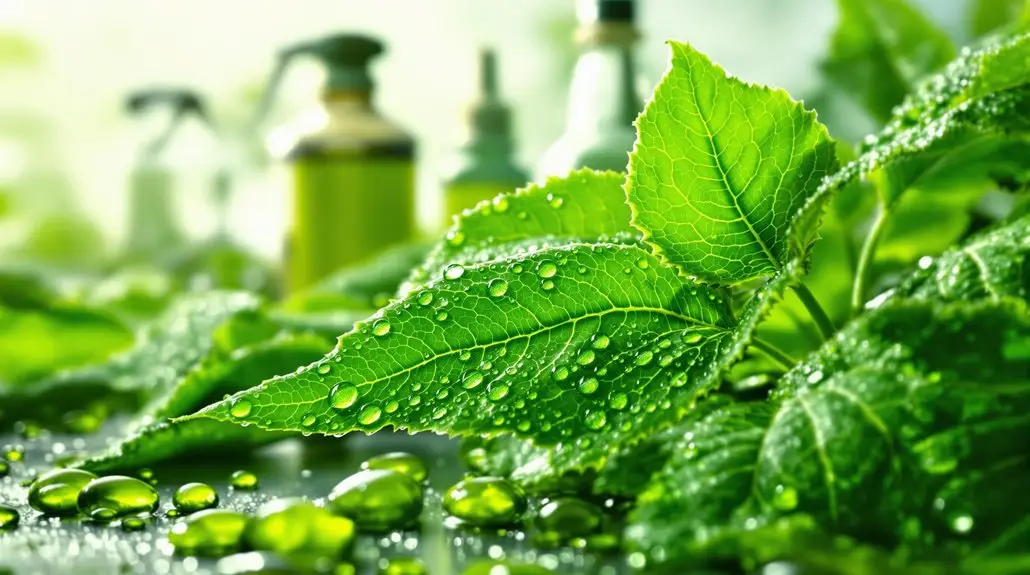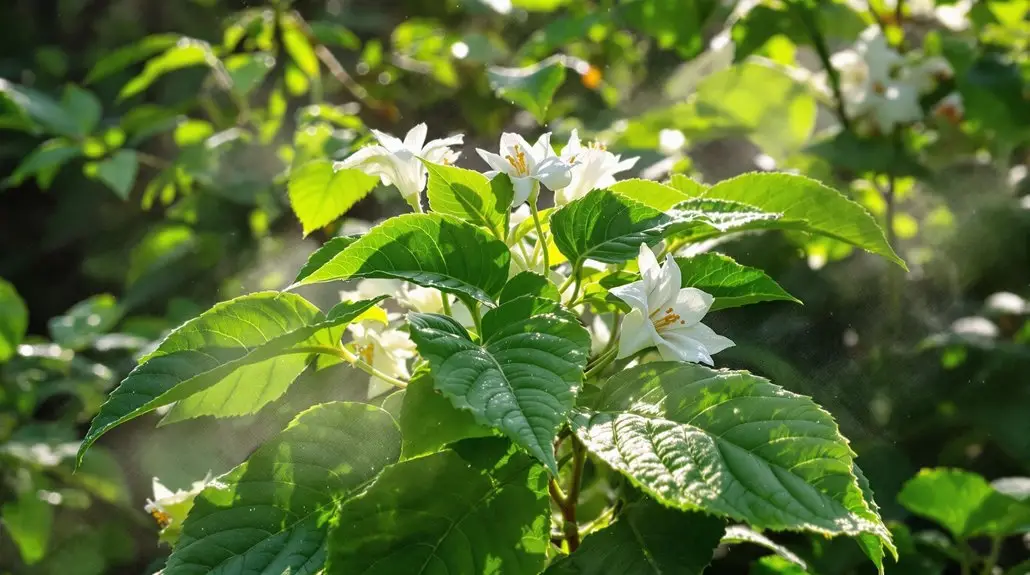Calycolpus moritzianus boasts a diverse array of bioactive compounds, primarily terpenes and flavonoids, that show promising insecticidal activity. The essential oil, rich in constituents like limonene and 1,8-cineole, disrupts crucial processes in pests, leading to high mortality rates. With an LC50 value of 73.29 µg/mL against Aedes aegypti larvae, it’s effective while presenting lower health hazards compared to synthetic insecticides. This eco-friendly option not only targets various pests but also minimizes environmental impact. Discover how this plant can reshape pest management practices in sustainable agriculture.
Key Insights
- Calycolpus moritzianus contains essential oils with major components like limonene and 1,8-Cineole, contributing to its pesticidal properties.
- The essential oil shows significant insecticidal efficacy with an LC50 value of 73.29 µg/mL against Aedes aegypti larvae.
- Its bioactive compounds disrupt pest biochemical processes by inhibiting acetylcholinesterase and affecting the electron transport chain.
- Compared to synthetic insecticides, it offers lower environmental impact and is biodegradable, making it a safer alternative.
- Ongoing research focuses on validating its insecticidal activity and promoting eco-friendly pest management strategies.
Overview of Calycolpus Moritzianus

Calycolpus moritzianus showcases remarkable adaptability and resilience, thriving in the diverse climates of Norte de Santander, Colombia, as well as in parts of Ecuador and Venezuela.
You’ll find this species in various regions, including the Venezuelan states of Barinas, Lara, Mérida, Táchira, and Trujillo, and in Colombian departments like Antioquia, Caldas, Boyacá, Cesar, Cundinamarca, Norte de Santander, and Santander.
Characterized by its upright leaves and distinctive solitary flowers or biparous cymes, Calycolpus moritzianus can grow to impressive heights of 10 to 15 meters.
It flourishes at elevations between 700 and 2,200 meters above sea level, where temperatures typically range from 15 °C to 22 °C. This adaptability not only highlights its ecological significance but also its potential economic value. High genetic diversity within its populations contributes to its resilience and potential for adaptation to changing environments. Additionally, studies reveal that genetic variation is particularly pronounced in fragmented populations, which is critical for its survival.
The species is an essential resource for local communities, providing wood, live fences, and fuel.
However, its popularity has led to concerns over indiscriminate logging and overexploitation.
Beyond its practical uses, Calycolpus moritzianus plays a role in cultural traditions, contributing to crafts, desserts, and beverages that bring people together.
Research shows high genetic diversity within its populations, particularly in Ocaña, where unique traits emerge.
This genetic richness enhances its resilience and underlines the importance of conserving this remarkable species, ensuring that future generations can cherish its benefits and cultural significance.
Chemical Components of Extract
The remarkable adaptability of Calycolpus moritzianus is mirrored in the complexity of its chemical profile. This plant boasts a rich essential oil, with major constituents that contribute to its unique characteristics. You’ll find that the concentrations of these components can vary greatly across different regions in Norte de Santander, Colombia, showcasing the plant’s versatility.
Here are some key chemical components you might find interesting:
- Limonene (17-38%)
- 1,8-Cineole (Eucalyptol) (12-43.3%)
- α-Pinene (2.3-5.6%)
- β-Caryophyllene (0.1-8.9%)
- α-Terpineol (0.2-5.5%)
Employing advanced techniques like Simultaneous Distillation-Solvent Extraction (DES) and Gas Chromatography High Resolution (CGAR), researchers have identified a total of 32 compounds within the essential oil.
Along with the primary constituents, additional compounds like Guaiol (0.3-20.2%) also contribute to the oil’s profile. The presence of these bioactive compounds lends commercial and biological importance, including reported antimicrobial properties and antioxidant activity. Notably, the essential oil composition has shown potential in antimicrobial activity, reflecting its utility in various applications.
As you explore the potential of Calycolpus moritzianus, you’ll appreciate how its diverse chemical makeup not only highlights its adaptability but also opens doors for various pharmacological applications.
The plant’s essential oil serves as a proof of nature’s ingenuity and the endless possibilities it offers.
Lethal Concentration Findings

When you look at the lethal concentration findings for Calycolpus moritzianus, you’ll see that the LC50 values play an important role in evaluating its efficacy. By comparing these values across different microorganisms, you can gauge the essential oil’s overall effectiveness and security profile. Additionally, understanding the toxicity tendencies of essential oils can further contextualize their potential applications in natural medicine. Notably, concerns about neonicotinoid exposure have prompted a reevaluation of pesticide use in agriculture, which may influence future comparisons with natural compounds. Furthermore, the growing trend towards natural and organic pest control solutions highlights the importance of exploring such alternatives. Let’s explore how these findings stack up against other compounds regarding antimicrobial action.
LC50 Value Analysis
Understanding the LC50 value for Calycolpus moritzianus extracts is vital for evaluating their potential toxicity. While no direct LC50 data currently exists for these extracts, grasping the general principles of LC50 can help you appreciate their implications for security and environmental impact.
Here’s what you need to know:
- LC50 measures the concentration lethal to 50% of test subjects over a set time.
- Values are expressed in parts per million (ppm) or parts per billion (ppb).
- Shorter exposure times require higher concentrations to achieve lethality.
- LC50 is specific to inhalation toxicity, unlike LD50, which pertains to oral and dermal routes.
- Lower LC50 values indicate higher toxicity.
As you consider the potential use of Calycolpus moritzianus in pest control, remember that factors like exposure duration, concentration, and environmental conditions greatly influence toxicity. Additionally, the genetic diversity of Calycolpus moritzianus may play a role in its effectiveness as a pesticide, as variations among populations can affect bioactive compound levels. Recent studies have shown that neonicotinoid insecticides significantly impact bird populations, highlighting the need for careful evaluation of all pesticide effects on wildlife.
Understanding the LC50 is vital for evaluating the safety risks associated with pesticide use. This knowledge helps you make informed decisions and contribute to safer practices in your community, ensuring that you and others are protected from potential hazards.
Comparative Efficacy Assessment
How do the insecticidal properties of *Calycolpus moritzianus* essential oils stack up against other pest control options? When you look at its LC50 value of 73.29 µg/mL against *Aedes aegypti* larvae, it shows promise but isn’t the most effective.
For instance, *Steiractinia aspera* boasts a superior LC50 of 42.4 µg/mL. This means that while *Calycolpus moritzianus* has potential, particularly through its active compounds like terpinen-4-ol, others might offer better results.
The insecticidal action appears linked to its ability to disrupt mitochondrial functions. This could pave the way for new, more secure insecticides that target specific enzymes and pathways in pests. Furthermore, research highlights that essential oils can provide crucial insights for designing new insecticides targeting mitochondria and acetylcholinesterase (AChE). Additionally, understanding the efficacy of various insecticides, including conventional insecticides, is essential for effective pest management.
However, it’s essential to compare its efficacy with conventional options like etofenprox and deltamethrin, which have proven highly effective.
Furthermore, the residual activity of insecticides plays a critical role in their overall effectiveness. As you explore natural solutions, understanding how *Calycolpus moritzianus* fits into the broader picture of pest control can help you make informed choices for effective and sustainable practices.
Secondary Metabolites Identified
In exploring the secondary metabolites of Calycolpus moritzianus, you’ll find that flavonoids and terpenes play a significant role in its bioactivity. These compounds exhibit anti-angiogenic properties, which could influence their potential insecticidal mechanisms. Additionally, research has shown that Calycolpus moritzianus exhibits potential anti-angiogenic activity, which supports its effectiveness in pest management. Understanding these metabolites helps clarify how this plant might interact with pests and support its pesticidal composition. Furthermore, the presence of diverse phytochemical compounds in this species enhances its potential for broader applications in pest control strategies.
Flavonoids and Terpenes
Calycolpus moritzianus is rich in secondary metabolites, particularly flavonoids and terpenes, which play crucial roles in its pesticidal properties.
These compounds not only enhance the plant’s defense mechanisms but also hold potential for use as natural pesticides.
Here’s what you should know about these fascinating compounds:
- Flavonoids are known for their beneficial health properties and can disrupt essential processes in pests.
- They’ve been isolated from the leaf extracts of Calycolpus moritzianus, demonstrating their availability for potential applications.
- Terpenes contribute to the plant’s aroma and flavor, while also exhibiting significant pesticidal activity, especially against Aedes aegypti.
- The essential oil from this plant has shown an impressive LC50 of 73.29 µg/mL, indicating its potency.
- Both flavonoids and terpenes have mechanisms that inhibit crucial enzymes and cellular processes in pests, enhancing their effectiveness.
- Recent studies have shown that essential oils from American native plants can provide effective alternatives to synthetic pesticides.
- Notably, the diversity of terpene profiles aids in strain identification, showcasing their importance in understanding the plant’s biological functions.
Understanding these secondary metabolites not only deepens your appreciation for nature’s ingenuity but also opens doors to sustainable pest control solutions.
Anti-Angiogenic Properties
Building on the fascinating role of flavonoids and terpenes in pest control, the extracts of Calycolpus moritzianus also reveal significant anti-angiogenic properties. You’ll find that these extracts interact particularly with the vascular endothelial growth factor receptor-1 (VEGFR-1), a key player in the process of angiogenesis. By inhibiting the interaction between VEGF or PlGF and Flt-1 at a concentration of 100 microg/mL, the methanolic and chloroform extracts show promise in mitigating new blood vessel formation, an essential aspect of cancer progression. Recent studies have highlighted that natural products provide diverse compounds for drug discovery against tumor angiogenesis. Phytochemical investigations have isolated specific flavonoids and terpenes from C. moritzianus, showcasing their potential in cancer treatment. These bioactive compounds could be vital in developing new anti-cancer therapies. The biodiversity of C. moritzianus contributes to the richness of its phytochemicals, making it a valuable resource for further research. As you explore the anti-angiogenic properties of C. moritzianus, it’s clear that this plant holds potential in addressing diseases characterized by aberrant angiogenesis. Additionally, the presence of phenolic compounds in related species like Ziziphus lotus indicates a broader significance of plant extracts in therapeutic applications. Your interest in natural compounds can lead to exciting discoveries in the field of cancer treatment.
Insecticidal Mechanisms Explained
Exploring the insecticidal mechanisms of Calycolpus moritzianus reveals a complex interplay of secondary metabolites that contribute to its effectiveness against pests. The essential oils of this plant contain significant components like terpenes and flavonoids, which play essential roles in its insecticidal activity.
Here are some key points to reflect on:
- Toxicity Levels: The essential oils exhibit an LC50 value of 73.29 µg/mL against Aedes aegypti larvae.
- Mechanism of Action: They disrupt the electron transport chain, inhibiting critical mitochondrial enzymes and acetylcholinesterase (AChE) activity. Biorational insecticides are increasingly sought after for their low toxicity to non-target species, highlighting the importance of sustainable pest management.
- Major Components: Terpenes, including sesquiterpenes and monoterpenes, enhance the insecticidal effect.
- In Silico Insights: Computational methods suggest how these metabolites bind to AChE, providing a pathway for developing new insecticides.
- Bioactive Potential: The phytochemical investigation underscores the potential of these compounds in secure insecticide design.
Mechanisms of Insecticidal Activity

Numerous mechanisms underlie the insecticidal activity of Calycolpus moritzianus, making it an intriguing subject for pest management. You’ll find that its essential oils (EOs) disrupt various cellular processes in insects, leading to effective pest control. For instance, they can interfere with the electron transport chain, inhibit mitochondrial functions, and even disrupt neurotransmitter actions, particularly affecting acetylcholinesterase (AChE) activity. The synergistic effects of thymol with other extracts may enhance the overall efficacy of these bioactive compounds in pest management. Additionally, the use of organic pest control strategies aligns with the principles of utilizing natural solutions for effective pest management.
Here’s a quick overview of the mechanisms involved:
| Mechanism | Description |
|---|---|
| Electron Transport Disruption | Impairs mitochondrial enzyme activity |
| Neurotransmitter Interference | Targets AChE, disrupting communication within insects |
| Cellular Stress Induction | Causes stress that can lead to insect mortality |
| Enzyme Inhibition | Blocks essential enzymes important for survival |
| Physiological Effects | Results in high mortality rates, especially in larvae |
The bioactive compounds in Calycolpus moritzianus bind to specific proteins, further inhibiting crucial biochemical processes. They even show potential in guiding the development of new insecticides tailored to target specific pathways. You’ll notice that EOs not only affect mortality rates but can also induce sublethal effects, such as reduced growth and fertility, which ultimately impacts insect populations. These targeted actions on different life stages, especially larvae, highlight the plant’s potential as a strategic tool in pest management. Embracing nature’s own solutions can foster a sustainable approach to controlling pests.
Comparison With Essential Oils
When you compare Calycolpus moritzianus with other essential oils, you’ll notice varying efficacy against mosquito larvae, particularly Aedes aegypti. Understanding the mechanisms of action behind these differences can highlight eco-friendly alternatives for pest control. Notably, Calycolpus moritzianus exhibited an LC of 73.29 µg/mL after 24 hours, demonstrating its larvicidal activity in comparison to other EOs. Moreover, utilizing natural pest control methods aligns with the growing demand for environmentally-friendly solutions in pest management.
Efficacy Against Mosquito Larvae
In the quest for effective mosquito control, the efficacy of Calycolpus moritzianus essential oil against mosquito larvae stands out. With an LC50 value of 73.29 µg/mL after 24 hours, it shows promise, but it’s vital to recognize that it’s not the most potent option compared to other essential oils.
For instance, oils from _Steiractinia aspera_ and _Piper aduncum_ exhibit lower LC50 values, indicating higher effectiveness.
Here’s what you should know:
- Biological activity disrupts the electron transport chain in mosquito larvae.
- Potential for development as a natural insecticide exists.
- Comparative studies have shown a range of effectiveness among essential oils.
- Diverse phytochemical profiles contribute to varying insecticidal activities.
- Research is ongoing to further explore its insecticidal properties.
- Integrating larviciding methods into existing approaches can enhance overall mosquito control efforts.
- Community engagement is essential for the successful implementation of natural pest control strategies.
While Calycolpus moritzianus offers valuable insights, it’s important to continue investigating its potential alongside other oils.
The journey to discover effective, natural solutions for mosquito control is collaborative, and every piece of research contributes to a healthier environment. Let’s embrace this opportunity together!
Mechanisms of Action
Calycolpus moritzianus showcases a unique mode of action that sets it apart from other plant-derived essential oils. Its essential oils disrupt the electron transport chain in mitochondria, leading to effective insecticidal activity. You’ll find that the major components can inhibit significant mitochondrial enzymes and acetylcholinesterase (AChE), which are essential for insect survival. Molecular docking studies even suggest how these secondary metabolites might bind to these enzymes, enhancing their effectiveness.
When you compare the larvicidal activity of Calycolpus moritzianus, with an LC50 of 73.29 µg/mL, it holds its own against other plant-derived oils. The mechanisms of action align with those of oils from plants like Steiractinia aspera, emphasizing mitochondrial disruption as a common strategy. What’s particularly exciting is the essential oil’s rich composition of monoterpenes, like terpinen-4-ol, known for their antimicrobial properties.
This diversity not only contributes to its insecticidal and antimicrobial effects but also highlights the potential for synergistic enhancements when mixed with other oils. Importantly, the identification of bioactive molecules from this plant furthers the understanding of its potential in eco-friendly pest management strategies.
Fundamentally, Calycolpus moritzianus stands out as a promising natural insecticide alternative.
Eco-Friendly Alternatives
How do eco-friendly alternatives stack up against essential oils in pest management? When you consider their effectiveness, security, and environmental impact, essential oils like those from Calycolpus moritzianus offer a promising option, but they also come with challenges.
Here’s a quick comparison to help you decide:
- Biodegradable: Essential oils break down naturally, making them secure for pets and wildlife.
- Broad Spectrum Activity: They can target a variety of pests effectively.
- Specific Target Action: You can use them in different ways for direct pest control. Additionally, natural pest deterrents such as peppermint oil can repel spiders and ants effectively.
- Commercial Viability: Some oils, like terpinen-4-ol, have found a niche in the market.
- Higher Application Rates: Essential oils often need more frequent applications compared to synthetic pesticides. Additionally, proper identification of active ingredients is crucial to ensure safety and efficacy in product use.
While essential oils shine in their eco-friendliness, they can fall short in efficacy and cost-effectiveness.
Alternatives like neem oil, peppermint oil, and diatomaceous earth also present viable options, each with unique benefits.
You’re not alone in seeking sustainable pest management solutions, and exploring these alternatives can help you make informed choices for a healthier environment.
Evaluation of Insecticidal Efficacy

Evaluating the insecticidal efficacy of essential oils from various plant sources reveals promising results, particularly with *Calycolpus moritzianus*. You’ll find that the essential oils extracted from this plant contain a rich variety of biogenic organic compounds, including terpenoids and sesquiterpenes, which contribute to their insecticidal properties. Studies show that these oils can effectively repel and kill pests, making them a viable option for those seeking eco-friendly pest control solutions. Additionally, the strong biological activity of essential oils from other plants like *Eucalyptus robusta* supports their development as natural agrochemicals.
Here’s a quick comparison of the insecticidal activity of various essential oils:
| Plant Source | LC50 Values (mL/L) |
|---|---|
| *Calycolpus moritzianus* | Nymphs: 36.47-93.15 |
| Adults: 60.72-111.00 | |
| *Eucalyptus robusta* | Varies based on concentration |
The essential oils from *Calycolpus moritzianus* demonstrate a strong repellent effect against *Diaphorina citri*, with high concentrations achieving up to 100% repellency rates. Even though the repellent rates may decrease with prolonged exposure, the concentration plays a vital role in effectiveness.
As you explore the potential applications of these oils, consider the greener alternatives they offer compared to chemical insecticides. The diversity of volatile biogenic organic compounds in *Calycolpus moritzianus* hints at its significant potential for sustainable pest management. Embracing these natural solutions could enhance your connection to a healthier environment.
Screening Protocols and Methods
Screening protocols and methods for evaluating the pesticidal composition of *Calycolpus moritzianus* involve a series of systematic approaches to guarantee accurate and reliable results.
You’ll find that these protocols encompass sample collection, chromatographic analysis, compound identification, and biological activity assessment. Each step is vital for making certain the data you gather is both valid and reproducible.
Here’s a quick overview of the screening protocols:
- Sample Collection: Utilize adsorption/thermal desorption cartridges and solid-phase microextraction fibers for air samples.
- Chromatographic Analysis: Implement two-dimensional gas chromatography/time-of-flight mass spectrometry for swift analysis of volatile organic compounds (VBOCs). This technique provides enhanced resolution and sensitivity for analyzing complex mixtures.
- Compound Identification: Rely on chromatographic retention index values to identify and quantify various VBOCs present. Additionally, the integration of DNA technology can further enhance the reliability of compound identification.
- Biological Activity Assessment: Evaluate the insecticidal effects on larvae, using established methods to determine LC50 values.
- Replicability: Conduct each bioassay with four independent experiments to guarantee robust results.
These methods not only enhance the credibility of your findings but also build a community of researchers who value thoroughness and rigor.
As you engage with these protocols, you’re contributing to a greater understanding of the pesticidal properties of *Calycolpus moritzianus*. Embrace the journey of exploration and discovery, and know that your efforts are paving the way for future advancements in eco-friendly pest management!
Comparison With Conventional Pesticides

When comparing the pesticidal properties of *Calycolpus moritzianus* to conventional pesticides, it’s clear that natural alternatives offer distinct advantages. The essential oil of C. moritzianus showcases effective larvicidal activity against Aedes aegypti, achieving an LC50 of 73.29 µg/mL within 24 hours. While it outperforms some natural pesticides, it falls short against synthetic options like temephos regarding mortality rates. However, the lower health and environmental hazard classifications of C. moritzianus provide a compelling reason to evaluate it. Additionally, studies have shown that conventional pesticides often carry significantly more health hazard statements compared to organic alternatives. Recent research has demonstrated that biorational insecticides can be highly effective in pest management, which further emphasizes the potential of C. moritzianus.
Here’s a quick comparison of *Calycolpus moritzianus* with conventional and other biopesticides:
| Feature | *Calycolpus moritzianus* | Conventional Pesticides |
|---|---|---|
| Health Hazard Classification | Lower | Higher |
| Environmental Impact | Minimal | Significant |
| Target Specificity | High | Variable |
The diverse volatile compounds released by C. moritzianus not only contribute to its pesticidal effectiveness but also enhance its role in sustainable agriculture. Unlike synthetic pesticides, which can disrupt entire ecosystems, the natural compounds in C. moritzianus target specific mitochondrial functions in pests, minimizing collateral damage.
In a world increasingly concerned about health and environmental issues, *Calycolpus moritzianus* represents a promising alternative that aligns with values of sustainability and ecological balance. By embracing such natural solutions, you’re part of a larger community aiming for a healthier planet.
Regulatory Considerations in Pesticides
When you’re considering the use of pesticides, understanding ingredient regulations and compliance is essential. The EPA sets strict guidelines for labeling to guarantee secure application and effectiveness. RNA interference (RNAi) presents a specific and sustainable approach for pest control in the development of new pesticide technologies. The USA, EU, Brazil, and China are leading global agricultural producers, significantly influencing pesticide usage and regulation worldwide.
Pesticide Ingredient Regulations
Pesticide ingredient regulations play an essential role in ensuring security and efficacy in agricultural practices. These rules help protect not just the environment but also the health of those who use and consume these products. Understanding these regulations can empower you as a responsible user.
Here are some key points to reflect on:
- Active Ingredients: Must be clearly identified on labels, including their weight percentage.
- Inert Ingredients: Essential for product effectiveness but require EPA approval.
- Regulatory Framework: Governed by the Federal Insecticide, Fungicide, and Rodenticide Act (FIFRA) and others.
- Safety Standards: Active ingredients undergo rigorous evaluation for health and environmental impacts.
- Scientific Scrutiny: There’s ongoing debate about the combined effects of active and inert ingredients. Additionally, the EPA evaluates pesticides to ensure they meet federal safety standards before registration, making sure to assess potential human health risks.
Labeling and Compliance
Understanding pesticide ingredient regulations is just the beginning; labeling and compliance are equally important for protected and effective use. When you’re dealing with pesticides like Calycolpus Moritzianus, every product must display essential information. This includes the product name, producer’s details, net contents, registration number, and the establishment number. Each label must clearly present these facts, guaranteeing you have all the necessary information at your fingertips. Moreover, don’t overlook hazard statements and precautionary guidelines that are vital for security. Regulatory bodies like the EPA in the U.S. and PMRA in Canada make sure that pesticides undergo thorough assessments before they hit the market. They evaluate safety and efficacy, so you can trust what you’re using. In addition, it’s crucial to recognize that pests and diseases cause significant losses in crop production, emphasizing the need for effective pest management solutions. Furthermore, all labels must include ingredient statements that accurately reflect active and inert ingredients, ensuring transparency for users.
If you’re importing pesticides, remember that they need to meet labeling requirements, including EPA-approved FIFRA labels. Unregistered products require specific documentation, especially if they’re for research and development. Compliance isn’t just about following the rules; it’s about creating a more secure environment for you and your community. Stay informed and engaged, and you’ll be part of a responsible pesticide-use community.
Future Research Directions

Exploring future research directions for the pesticidal composition of Calycolpus moritzianus opens up a wealth of opportunities to deepen our understanding of its potential applications.
To fully harness the benefits of this fascinating plant, you’ll want to take into account several avenues for future research. Each path not only enhances our knowledge but also fosters a sense of community among researchers and practitioners alike.
- Detailed Analysis of Essential Oils: Investigate the full range of compounds present in the essential oils.
- Isolation and Characterization: Focus on isolating and characterizing bioactive compounds like terpinen-4-ol and limonene.
- Biochemical Pathways: Elucidate the biochemical pathways involved in the plant’s pesticidal activities. Research could also reveal how genetic diversity contributes to the variability in essential oil composition.
- Environmental Security: Evaluate the safety of these compounds on non-target organisms to guarantee eco-friendliness.
- Integration with IPM: Explore how Calycolpus moritzianus can complement integrated pest management strategies.
Potential Applications in Agriculture
Calycolpus moritzianus holds promising potential for revolutionizing agricultural practices, particularly through its insecticidal properties. The essential oils derived from this plant contain bioactive compounds that demonstrate significant insecticidal activity, especially against Aedes aegypti larvae. With an LC50 of 73.29 µg/mL, these oils could offer a practical solution for pest control in your farming operations.
Imagine being able to reduce reliance on synthetic pesticides while still effectively managing pest populations. Using Calycolpus moritzianus essential oils mightn’t only guarantee more secure crops but also align your practices with the growing trend towards sustainable agriculture.
The diverse composition of these oils, rich in monoterpenes and sesquiterpenes, suggests multiple avenues for application. By integrating these natural solutions into your pest management strategies, you may enhance crop resistance and foster a healthier ecosystem.
As you consider the potential for biopesticide development, it’s important to recognize the commercial viability of these products. The increasing demand for eco-friendly alternatives in agriculture means that adopting Calycolpus moritzianus could set you apart in the market.
However, it’s vital to conduct thorough studies on their efficacy and security in real-world settings to confirm you’re making informed decisions. Incorporating this plant into your agricultural practices couldn’t only benefit your crops but also contribute to a broader movement towards sustainability in farming.
Together, we can embrace innovative solutions that promote a healthier environment for all.
Eco-friendly Pesticide Development

The rise of eco-friendly pesticide development is transforming the agricultural landscape, offering farmers sustainable solutions that align with consumer preferences.
As you explore these innovations, you’ll find that the natural pesticide market is rapidly expanding. By 2032, it’s projected to reach $7.6 billion, showcasing a growing awareness of health and environmental risks.
Here are some exciting trends driving this movement:
- Regulatory Support: Governments are implementing stricter regulations on synthetic pesticides, promoting sustainable practices.
- Increased Demand: Consumers are actively seeking organic food, influencing farmers to adopt eco-friendly solutions.
- Innovative Methods: Techniques like biological control and integrated pest management (IPM) are leading the way in pest control. Additionally, natural pesticides are often effective in reducing pest populations with minimal environmental impact.
- Environmental Focus: Eco-friendly pesticides minimize harm to the environment, supporting sustainable living practices.
- Technological Innovations: Tools like automated pest detection systems are enhancing proactive pest management. Additionally, the importance of sustainable farming practices is gaining recognition as vital for environmental health and agricultural resilience.
Synergistic Effects of Components
Natural compounds in essential oils can exhibit remarkable synergistic effects, enhancing their potential as eco-friendly pesticides. When you explore the essential oil of Calycolpus moritzianus, you’ll find a complex blend of volatile biogenic organic compounds (VBOCs), including isoprene, monoterpenes, and sesquiterpenes. This diversity is significant because it allows for interactions among components, which can elevate their bioactivity.
Research shows that Calycolpus moritzianus exhibits significant larvicidal activity against Aedes aegypti larvae, with an LC50 of 73.29 µg/mL. This effect isn’t just about one compound working alone; it’s about how different compounds work together. For example, studies indicate that the synergy among these natural plant compounds can disrupt vital biological processes, like the electron transport chain in mitochondria. This means that individual components can amplify each other’s effects, creating a stronger overall impact. Additionally, the observed synergistic effects in pesticide mixtures support the idea that natural compounds can enhance toxicity through combined interactions.
Moreover, the presence of sesquiterpenes and other compounds can increase toxicity in low doses, which is beneficial for developing effective pesticide strategies. You can think of it like a well-coordinated team, where each member contributes to a common goal.
Implications for Human Health Risks

Understanding the implications for human health risks associated with the pesticidal composition of *Calycolpus moritzianus* is vital, especially given the potential toxicity of its essential oils. You mightn’t realize that compounds like terpinen-4-ol and limonene can pose serious health risks if used improperly. The LC50 values indicate that these oils can be lethal at high concentrations, raising concerns about their security for both humans and the environment.
Here are some key considerations for your awareness:
- Toxicity Levels: High concentrations of these essential oils can be harmful.
- Environmental Contamination: Pesticides may contaminate water sources, leading to unintended human exposure.
- Cumulative Effects: Long-term exposure to pesticides can contribute to chronic health issues.
- Human Exposure Pathways: You can be exposed to pesticides through food and drinking water.
- Regulatory Gaps: Current regulations may not fully assess pesticide risks or guarantee security, which is concerning given the PMRA’s re-evaluation of pesticides every 15 years.
Being aware of these risks is important for making informed choices about pesticide use.
It’s important for you to support proper management practices and advocate for more thorough studies on the health implications of *Calycolpus moritzianus*.
By staying informed and engaged, you can contribute to a more secure environment for yourself and your community.
Together, we can push for stricter safety standards and better public communication about the risks associated with these substances.
Your voice matters in this conversation about health and security.
Frequently Asked Questions
How Can Calycolpus Moritzianus Be Cultivated for Pesticide Production?
To cultivate Calycolpus moritzianus for pesticide production, you’ll want to choose a location with similar climatic conditions to its native habitat.
Focus on maintaining its genetic diversity by selecting seeds from various populations. Guarantee proper soil preparation and irrigation.
Regularly monitor growth and health of the plants, as healthy specimens yield better essential oils.
Harvest at the right time and preserve samples correctly for processing, maximizing their potential as natural pesticides.
What Are the Environmental Impacts of Using Calycolpus Moritzianus Extracts?
As the saying goes, “you reap what you sow.”
When you use *Calycolpus moritzianus* extracts, you might disrupt local ecosystems, affecting insect populations and biodiversity.
Over-extraction for wood and fuel already threatens its conservation.
While these natural extracts could offer more secure alternatives to synthetic pesticides, the long-term impacts on the environment and human health need careful consideration.
It’s essential to balance your agricultural practices with sustainability to protect our shared planet.
Are There Any Known Side Effects of Calycolpus Moritzianus on Non-Target Organisms?
You might be curious about the side effects of Calycolpus moritzianus on non-target organisms.
Unfortunately, specific studies haven’t been conducted yet. While similar plant extracts have shown toxicity to various organisms, there’s no direct data for this species.
The variability in its essential oils can influence potential impacts, so it’s important to approach its use cautiously.
More research will help clarify these unknowns and guarantee secure applications in your gardening or pest control efforts.
What Methods Are Used to Extract Essential Oils From Calycolpus Moritzianus?
When you’re looking to extract essential oils from Calycolpus moritzianus, you might consider techniques like Solid Phase Microextraction (SPME) for analyzing volatile compounds.
Though specific methods for this plant aren’t detailed, Gas Chromatography coupled with Time-Of-Flight Mass Spectrometry (GC × GC-TOFMS) can help you identify the oil’s composition.
While extraction methods may vary, these analytical techniques provide an insightful understanding of the essential oils’ potential benefits and uses.
How Does Calycolpus Moritzianus Compare to Traditional Organic Pesticides?
Did you know Calycolpus moritzianus has an LC50 of 73.29 µg/mL, making it a strong contender among traditional organic pesticides?
It disrupts pest mitochondrial functions, similar to how neem oil and pyrethrin work.
You’ll find that while both options offer effective pest control, Calycolpus moritzianus provides a more sustainable alternative, promoting ecological health.
Choosing it not only helps your garden but also supports biodiversity, fostering a sense of community in organic farming.
Conclusion
To summarize, the pesticidal properties of Calycolpus moritzianus could revolutionize agriculture like a superhero swooping in to rescue the day! Its unique chemical components and identified secondary metabolites show great promise for eco-friendly pest control. By harnessing these natural insecticidal mechanisms, we can develop more secure alternatives to synthetic pesticides, benefiting both crops and the environment. Embracing this powerful plant could lead to healthier farming practices and a more sustainable future.
Join us at NaturePest Holistic Pest Control to explore the incredible potential of Calycolpus moritzianus and other natural solutions! Together, we can cultivate a greener tomorrow and protect our planet while ensuring thriving crops. Don’t miss out—discover how you can make a positive impact today!



